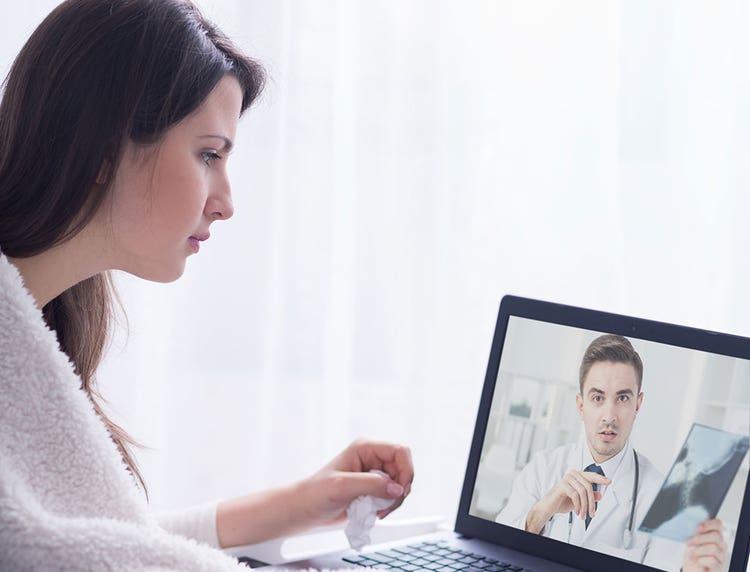The Modern House Call

Video-conference and apps bring fast diagnoses.
One night, Errold Webb’s son’s cold took a turn for the worse, as the swollen glands in his throat swelled and his fever rose. Webb called icalladoctor.com, an online service that allows both insured and uninsured to consult with a doctor via laptop, iPad or mobile phone. After a call with a doctor, a prescription was called in to his local pharmacy, and his son was back to school without missing a day.
“I have access to a doctor 24/7. The service is at a very minimal cost. With four kids it’s a great asset — saving us money and time,” noted Webb recently in an online post on the topic.
Over the next decade, virtual medicine is expected to shake up the health care business, as patients with routine ailments increasingly use their tablets, laptops and mobile phones to see a doctor or other medical professional when they need it, rather than waiting weeks for an appointment or visiting the local urgent care on weekends. Indeed, analysts say, some of these visits will soon be automated, providing treatment and prescriptions via algorithm, rather than physician; a prospect that many might find a little unsettling.
Rewards and risks
“You will log into a health and wellness platform, and it will help you decide when you are unwell, and when you need to be connected to a doctor,” says Thomas J. Handler, M.D., healthcare analyst for Gartner research. “It will free up highly skilled clinicians to do what they do best. You will get faster, better, cheaper care.”
Some in the medical community disagree, saying that hands-on exams are more accurate, and that the potential for misdiagnosis and overprescription is greater with digital care, even if it’s more convenient.
However, nine in 10 employers will make virtual doctor visits available to employees in the 47 states where it is allowed next year, according to the National Business Group on Health’s Large Employers’ 2017 Health Plan Design Survey, a significant jump from the 70 percent offering this service in 2016.
A whole host of apps and websites not affiliated with insurers are already offering virtual visits with family physicians, dermatologists and psychologists, most for a relatively affordable $40 to $50 a visit. Some of the country’s largest insurers, such as Anthem Blue Cross Blue Shield and UnitedHealthcare now cover these virtual visits.

How virtual care works
With new virtual care offerings such as Doctor On Demand, NowClinic and LiveHealthOnline, an affiliate of Anthem, you simply register and log in to videoconference with a doctor on your computer or mobile app.
With LiveHealthOnline, for example, you choose a doctor from those available at that hour, pay your insurance copay or the $49 visit fee and answer questions about your symptoms and medical history. A doctor reviews this information while you are in the virtual waiting room, and then pops up to videoconference with you about your problem. Doctors are available around the clock and on holidays to see patients.
Physicians say many of the minor conditions for which we take off work and see our doctor, such as pink eye, urinary tract infections, sinusitis, sore throats and sports injuries, could be handled by a virtual provider from the comfort of your own home, and at a time that’s convenient for you.
If a doctor spots a more serious or complicated problem, he or she will either refer you back to your own primary care physician or send you to the emergency room, says family physician Mia Finkelston, who heads the online practice for LiveHealthOnline, and who has had to do that with several cases of appendicitis.
Still, she says you’d be surprised at what a physician can treat with your mobile phone and its camera and microphone.
“It’s very easy to look at a sore throat, or put a sprained ankle through some tests,” she says. And a patient can hold the microphone up to the mouth so she can listen to his or her breathing.
Of course, the iPhone is no stethoscope, and there’s no way she can look in a patient’s ears or nose or order labs.
But, she says, perhaps because virtual care lacks these diagnostic tools, Finkelston says she has had to improve her listening and observation skills to make sure she’s making an accurate diagnosis. One benefit of virtual care, she says, is there is no one knocking on her door, urging her on to the next patient.
“They have my full attention.”
Where telemedicine started — and where it’s going
So-called telemedicine has actually been around for decades, but for much of this time, these services were used to connect patients in rural areas with doctors, or to give emergency room doctors round-the-clock access to specialists, such as a neurologist across the country who could help diagnose a stroke and make a critical decision, such as whether or not to give that patient a blood thinner to greatly improve his outcome.
“It’s been very effective in an acute care setting,” Handler says.
More recently, private-pay dermatology and mental health applications have taken off, in part because they are great fits for videoconferencing, text and chat.
With Spruce, a new dermatology app, you don’t even need to have a conversation with a human to resolve a skin problem such as acne, bug bites or eczema. Simply answer a few questions about your skin and symptoms, submit a few photos and $40 for the visit, and a dermatologist will deliver your diagnosis and email a prescription, if you need one, to your local pharmacy within 24 hours.
One of the greatest virtual care opportunities is mental health, with apps and sites allowing people to videoconference and message a psychologist in an environment in which they feel comfortable, and at a time when they need it the most.
In an American Psychological Association article, Carolyn Turvey, Ph.D., a professor of psychiatry at the University of Iowa, observes, “By insisting that patients come to our offices, we’re excluding potentially millions of patients who need care.”
The practice has been in place for 20 years at the Dept. of Veteran Affairs, but recently it has swelled among younger clients, many of whom are avoiding what they see as the stigma of seeing a therapist for everything from depression to marital problems to social anxiety.
Still, despite the convenience and growing availability of these services, the adoption of virtual care is still in the very early stages. An average of just 3 percent of eligible employees had a telehealth visit in the first half of 2016, according to the Large Employer survey, up from 1 percent in all of 2015.
Most people don’t know these services are out there, physicians say, and some just don’t feel comfortable yet with seeing someone other than their own doctor. But very soon, analysts say, even your local primary care physician will likely be triaging patients online and handling follow-ups via videoconference or text, rather than in person.
Quality of care is still key
By 2020, Handler says, 25 percent of all care in the U.S. will be provided virtually, as the technology evolves and more physicians adopt digital platforms.
“Today none of it works that well,” Handler says, with doctors in some cases overutilizing medication such as antibiotics and ordering too many imaging studies for injured patients. “I would define it as less virtual care and more convenient care.”
Of course, as with most services, the quality of care is highly dependent on the provider, and the information they are getting about your condition.
Soon, Handler says, it will be your trusted physician’s office providing this type of online service to patients, triaging the most critical in-person appointments, answering questions about illness, and scheduling mobile follow-ups — all with your medical records firmly in hand.
And many will soon be monitoring your weight, heart rate, blood pressure and blood glucose levels remotely, from an app such as Apple’s AirStrip on their smart watch, allowing them to provide better management of chronic conditions.
“When done correctly, it will result in better quality of care,” Handler says. “Until then,” he says, “it’s still kind of hit or miss.”